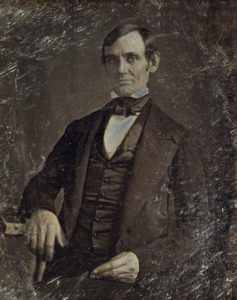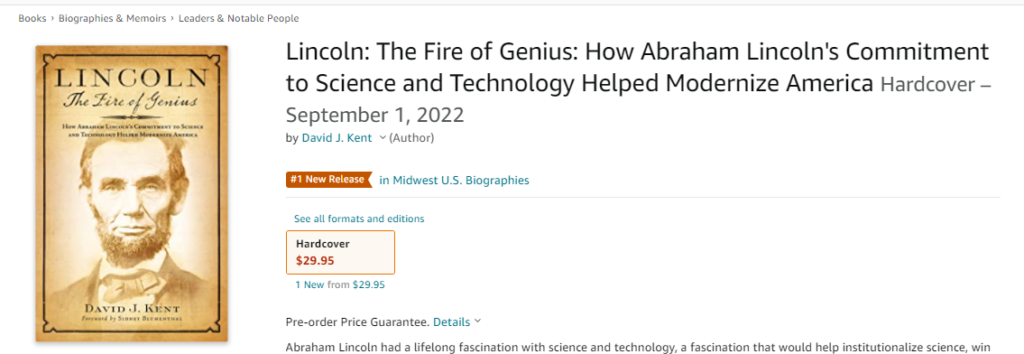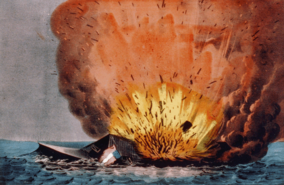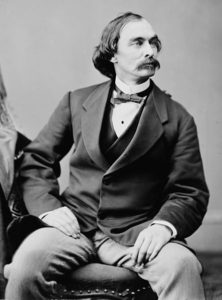 On March 23, 1860, one of Lincoln’s more famous cases came to trial in the U.S. District Court. Johnston v. Jones & Marsh, more commonly known as the Sand Bar case, was important both because of its subject matter (it highlighted Lincoln’s experience with technology) and because, in an age where trial transcripts were almost never kept, journalist Robert Hitt was paid to sit through the entire trial and create a comprehensive 482-page trial transcript, although he omitted the closing arguments.
On March 23, 1860, one of Lincoln’s more famous cases came to trial in the U.S. District Court. Johnston v. Jones & Marsh, more commonly known as the Sand Bar case, was important both because of its subject matter (it highlighted Lincoln’s experience with technology) and because, in an age where trial transcripts were almost never kept, journalist Robert Hitt was paid to sit through the entire trial and create a comprehensive 482-page trial transcript, although he omitted the closing arguments.
The case revolved around the accretion of new land created by various efforts to turn Lake Michigan’s shoreline at Chicago into a practical harbor, something nature had not designed it to do. Channels were dug, piers were built, and a great deal of sand was dredged. Eventually, Chicago had a harbor. In 1833, the government cut a channel across lakefront lots owned separately by William Johnston and William Jones. A newly erected pier caused the accretion of nearly 1,200 feet of new land, roughly six acres, which both Johnston and Jones claimed as their own. After four trials, the last of which found for Johnston, Jones appealed to the Supreme Court, which reversed the judgment and sent it back to the lower courts. At this point, Jones retained Lincoln and, after an 11-day trial, the jury sided with Jones.
The case highlighted Lincoln’s knowledge of natural environments and his clear, logical communication to jurors. A legal colleague, while not specifically talking about the Sand Bar case, seemed to capture the flavor of it when he called Lincoln “an admirable tactician” that “steered this jury from the bayous and eddies of side issues and kept them clear of the snags and sand bars, if any were put in the real channel of his case.” Fellow lawyer Leonard Swett also suggested Lincoln had a knack for focusing the juror on the key question while minimizing the rest. “By giving away six points and carrying the seventh, he carried the case.” Lincoln demonstrated this Euclidean logic and technical expertise in a letter to Johnson’s attorney Robert Kinzie before the trial, querying him on such technical matters as the intersection of the pier, the accreted new lakeshore, and the properties in question, as well as the timing of the land formation and any changes since the initial pier was erected. During the trial, Lincoln’s background in surveying helped him cross-examine the surveyor George Snow, catching that there were two maps created, each one alternatively benefiting the claims of the two litigants.
Lincoln’s questioning of the land surveys was key to winning the case. He was paid $350 for his services (about $11,600 today).
This was just one of many science and technology related cases in which Lincoln was involved, many setting important precedents for the modernization of America. More on that topic in Lincoln: The Fire of Genius: How Abraham Lincoln’s Commitment to Science and Technology Helped Modernize America, now available for pre-order.
Pre-order Lincoln: The Fire of Genius now on Amazon and Barnes and Noble (click on the respective links to pre-order). The price is likely to drop before the final shipment, and any pre-orders will automatically get charged the lower price at fulfillment. Pre-ordering now helps the publisher get a sense of the interest, which could mean a bigger print run. So please go ahead and pre-order without worries. While you’re there, check out my other books.
The book is also listed on Goodreads, the database where I keep track of my reading. Click on the “Want to Read” button to put it on your reading list. That will also ensure you get informed of the release date AND will let you try for one of ten free hardcover copies of the book that I’ll be giving away this summer. I’ll also be giving away as many as a hundred e-books. [The book will also be put out on audio]
You also follow my author page on Facebook.
I’ll have much more about the book over the next few months, so join my mailing list here to keep informed.
David J. Kent is President of the Lincoln Group of DC and the author of Lincoln: The Man Who Saved America. His previous books include Tesla: The Wizard of Electricity and Edison: The Inventor of the Modern World and two specialty e-books: Nikola Tesla: Renewable Energy Ahead of Its Time and Abraham Lincoln and Nikola Tesla: Connected by Fate.
Check out my Goodreads author page. While you’re at it, “Like” my Facebook author page for more updates!




 Abraham Lincoln spent much of his day on March 9, 1862 fretting over the battle of the ironclads. The Union ironclad Monitor had fought to a draw with the Confederate ironclad Virginia (former the USS Merrimack) at Hampton Roads, Virginia. The Virginia had been created from the burnt out hull of the Merrimack, left behind at Gosport Navy Yard at the beginning of the war after the state of Virginia seceded. The Merrimack was converted by the Confederate Navy into a seemingly indestructible metallic monster soon to prey on Union ships. Even though the ship was now officially the Virginia, the alliteration of Monitor and Merrimack (and the end of the Confederacy) means most people refer to the ship by its former name, both then and now.*
Abraham Lincoln spent much of his day on March 9, 1862 fretting over the battle of the ironclads. The Union ironclad Monitor had fought to a draw with the Confederate ironclad Virginia (former the USS Merrimack) at Hampton Roads, Virginia. The Virginia had been created from the burnt out hull of the Merrimack, left behind at Gosport Navy Yard at the beginning of the war after the state of Virginia seceded. The Merrimack was converted by the Confederate Navy into a seemingly indestructible metallic monster soon to prey on Union ships. Even though the ship was now officially the Virginia, the alliteration of Monitor and Merrimack (and the end of the Confederacy) means most people refer to the ship by its former name, both then and now.* Abraham Lincoln had a knack for meeting Arctic explorers. On March 1, 1862, Lincoln wrote to Secretary of War Edwin Stanton:
Abraham Lincoln had a knack for meeting Arctic explorers. On March 1, 1862, Lincoln wrote to Secretary of War Edwin Stanton:






